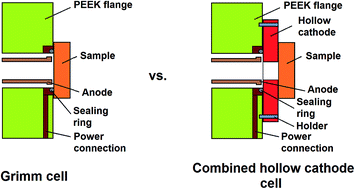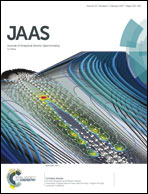Combined hollow cathode vs. Grimm cell: semiconductive and nonconductive samples
Abstract
Two commonly used discharge cells (Grimm type and hollow cathode) were studied and compared in respect of their analytical capabilities. Semiconductive (silicon, silicon carbide, gallium nitride) and nonconductive (quartz and alumina) samples were considered. In this connection a combined hollow cathode was used, which consists of a cylindrical cathode and a flat sample in the bottom of the cylinder. Aluminum, copper, and tantalum cylindrical cathodes were applied. The comparison of the discharge cells was made by the OES signal intensities of sample components at equal power and similar pressure conditions, either at continuous RF or pulsed DC power supply modes. Operating in continuous RF mode, the combined hollow cathode source was shown to give almost the same or higher intensities compared with the Grimm cell. The application of the hollow cathode with continuous RF mode has an appreciable advantage only for thick dielectric samples, because in contrast to the Grimm cell, for the hollow cathode the analytical signal was found to be independent on sample thickness. Operating in pulsed DC mode, the combined hollow cathode system produces up to several orders of magnitude higher intensities than the Grimm cell, especially for dielectric samples. The pulsed mode has also shown good ratios of sample to cathode intensities compared with the continuous one. The sputtering mechanism in the combined hollow cathode cell was investigated and found to be connected with the formation of a thin conductive layer on the sample surface. The composition and thickness of the latter, depending on operating parameters and sputtering time were studied. It was shown that the surface layer is generated as a result of hollow cathode disc material deposition, sample material redeposition and enrichment of the less sputtered sample component.



 Please wait while we load your content...
Please wait while we load your content...